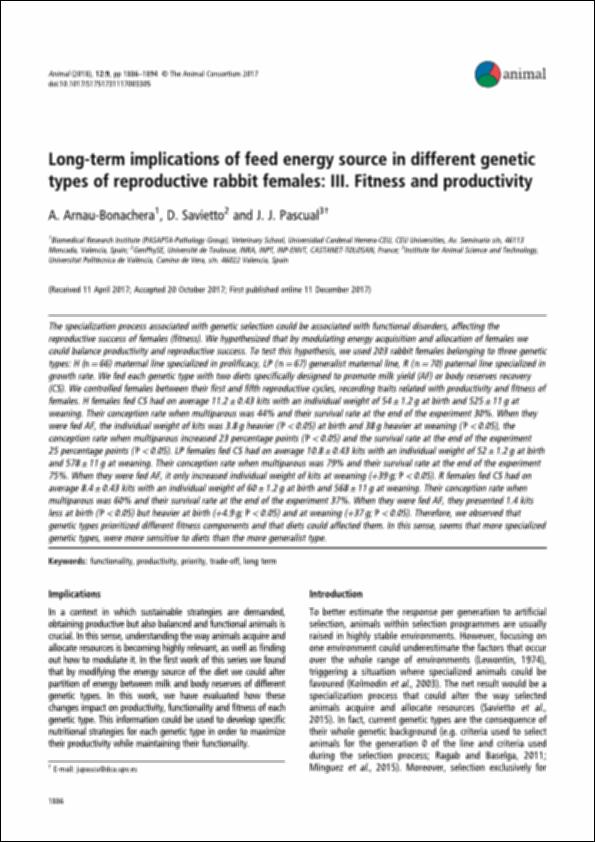Por favor, use este identificador para citar o enlazar este ítem:
http://hdl.handle.net/10637/10498Long-term implications of feed energy source in different genetic types of reproductive rabbit females. III, Fitness and productivity
| Título : | Long-term implications of feed energy source in different genetic types of reproductive rabbit females. III, Fitness and productivity |
| Otros títulos: | Fitness and productivity |
| Autor : | Arnau Bonachera, Alberto Savietto, Davi Pascual Amorós, Juan José |
| Materias: | Rabbits - Breeding.; Conejos - Reproducción.; Conejos - Alimentación.; Rabbits - Feeding and feeds.; Cereales.; Cunicultura.; Almidón.; Starch.; Conejos - Genética.; Rabbits - Genetics.; Rabbits - Reproduction.; Grain. |
| Editorial : | Cambridge University Press. |
| Citación : | Arnau Bonachera, A., Savietto, D. & Pascual, JJ. (2018). Long-term implications of feed energy source in different genetic types of reproductive rabbit females. III, Fitness and productivity. Animal, vol. 12, n. 9 (sept.), pp. 1886-1894. DOI: https://doi.org/10.1017/S1751731117003305 |
| Resumen : | The specialization process associated with genetic selection could be associated with functional disorders, affecting the reproductive success of females (‘fitness’). We hypothesized that by modulating energy acquisition and allocation of females we could balance productivity and reproductive success. To test this hypothesis, we used 203 rabbit females belonging to three genetic types: H (n=66) maternal line specialised in prolificacy, LP (n=67) generalist maternal line, R (n=70) paternal line specialised in growth rate. We fed each genetic type with two diets specifically designed to promote milk yield (AF) or body reserves recovery (CS). We controlled females between their first and fifth reproductive cycles, recording traits related with productivity and fitness of females. H females fed CS had on average 11.20.43 kits with an individual weight of 541.2 g at birth and 52511 g at weaning. Their conception rate when multiparous was 44% and their survival rate at the end of the experiment 30%. When they were fed AF, the individual weight of kits was 3.8 g heavier (P<0.05) at birth and 38 g heavier at weaning (P<0.05), the conception rate when multiparous increased 23 percentage points (P<0.05) and the survival rate at the end of the experiment 25 percentage points (P<0.05). LP females fed CS had on average 10.80.43 kits with an individual weight of 521.2 g at birth and 57811 g at weaning. Their conception rate when multiparous was 79% and their survival rate at the end of the experiment 75%. When they were fed AF, it only increased individual weight of kits at weaning (+39 g; P<0.05). R females fed CS had on average 8.40.43 kits with an individual weight of 601.2 g at birth and 56811 g at weaning. Their conception rate when multiparous was 60% and their survival rate at the end of the experiment 37%. When they were fed AF, they presented 1.4 kits less at birth (P<0.05) but heavier at birth (+4.9 g; P<0.05) and at weaning (+37 g; P<0.05). Therefore, we observed that genetic types prioritised different fitness 3 components and that diets could affected them. In this sense, seems that more specialised genetic types, were more sensitive to diets than the more generalist type. |
| Descripción : | Este artículo se encuentra disponible en la siguiente URL: https://www.sciencedirect.com/science/article/pii/S1751731117003305?via%3Dihub |
| URI : | http://hdl.handle.net/10637/10498 |
| Derechos: | http://creativecommons.org/licenses/by-nc-nd/4.0/deed.es |
| ISSN : | 1751-732X (Electrónico). 1751-7311 |
| Fecha de publicación : | 1-sep-2018 |
| Centro : | Universidad Cardenal Herrera-CEU |
| Aparece en las colecciones: | Dpto. Producción y Sanidad Animal, Salud Pública Veterinaria y Ciencia y Tecnología de los Alimentos |
Los ítems de DSpace están protegidos por copyright, con todos los derechos reservados, a menos que se indique lo contrario.


